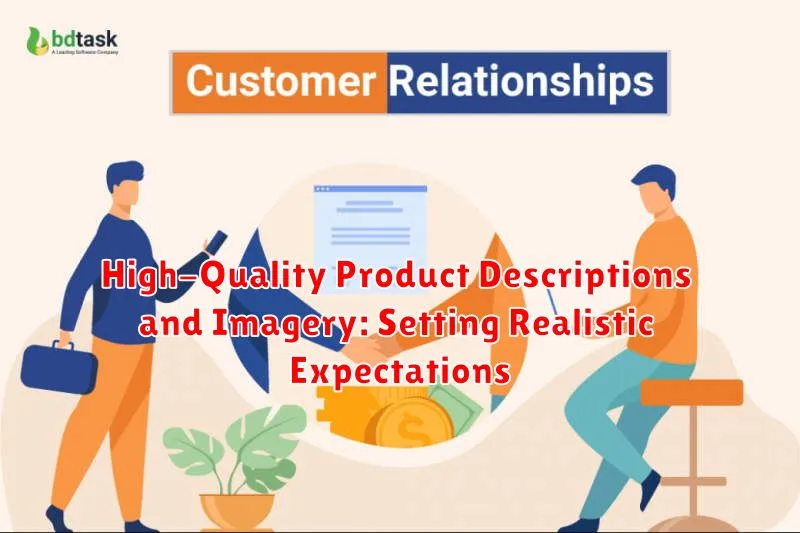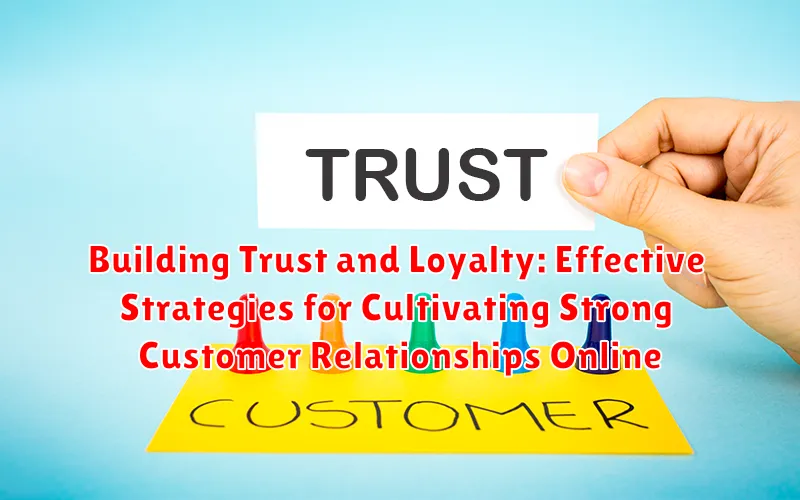In today’s digital landscape, building trust and loyalty with customers is paramount to the success of any online business. Customer relationships are the cornerstone of sustainable growth, and cultivating strong connections with your audience is essential for long-term profitability. This article explores effective strategies for building trust and fostering customer loyalty in the online environment. We’ll delve into the importance of customer relationships, explain why trust is the foundation of a loyal customer base, and discuss how to cultivate these crucial relationships through transparency, communication, and personalized experiences.
Cultivating strong customer relationships requires a dedicated and strategic approach. From understanding your target audience and their needs to leveraging various online platforms for engagement, building trust and loyalty necessitates a multi-faceted strategy. We will examine proven methods to nurture customer relationships online, including building a strong online presence, utilizing social media effectively, delivering exceptional customer service, and implementing loyalty programs designed to enhance customer loyalty. This article aims to provide practical insights and actionable steps for businesses seeking to build lasting and profitable customer relationships in the digital age.
Transparency and Authenticity: The Foundation of Customer Trust
In the digital age, transparency and authenticity are paramount to building strong customer relationships. Open communication fosters trust. Clearly communicate your business practices, including pricing, shipping, and return policies. Avoid hidden fees or misleading information. Be upfront about potential product limitations or challenges.
Authenticity builds connection. Share your brand’s story and values genuinely. Let customers see the human side of your business. This might involve showcasing your team, sharing behind-the-scenes glimpses of your operations, or highlighting customer testimonials. Authenticity resonates with customers and cultivates a sense of community around your brand.
Honest feedback is crucial. Encourage customer reviews and testimonials, both positive and negative. Respond to feedback constructively, demonstrating your commitment to improvement and customer satisfaction. Addressing negative feedback publicly shows a willingness to learn and grow, further strengthening trust.
Providing Excellent Customer Service: Going Above and Beyond
Exceptional customer service is paramount to building trust and loyalty online. Customers expect prompt, helpful, and personalized support. Responding efficiently to inquiries, whether through email, chat, or social media, demonstrates a commitment to customer satisfaction.
Empowering customer service representatives to resolve issues quickly and effectively is crucial. Providing them with the necessary tools and training allows them to handle diverse customer needs and go the extra mile. This might involve offering proactive solutions, personalized recommendations, or even small gestures of appreciation.
Streamlining the customer service process also contributes to a positive experience. A clear and accessible contact system, coupled with a comprehensive FAQ section, allows customers to easily find answers to common questions, reducing frustration and wait times.
Collecting customer feedback through surveys and reviews offers valuable insights into areas for improvement. Actively addressing concerns and implementing changes based on feedback demonstrates a willingness to listen and adapt, further solidifying customer trust and encouraging long-term loyalty.
High-Quality Product Descriptions and Imagery: Setting Realistic Expectations

Accurate and detailed product descriptions are crucial for building trust. Customers rely on this information to make informed purchasing decisions. Vague or misleading descriptions can lead to disappointment and erode trust. Provide comprehensive information about product features, dimensions, materials, and usage instructions.
High-quality product imagery complements detailed descriptions. Multiple images from various angles, showcasing different features and potential uses, allow customers to visualize the product clearly. Avoid heavily edited or unrealistic images that misrepresent the product’s true appearance. Strive for authenticity and transparency in visual representation.
Setting realistic expectations is essential. While showcasing the product’s benefits, avoid exaggerating or over-promising. Accurately represent the product’s capabilities and limitations. This honesty helps manage customer expectations, leading to greater satisfaction and long-term trust.
Secure Payment Gateways and Data Privacy: Protecting Customer Information
In the digital age, ensuring the security of customer information is paramount to building trust and fostering long-term relationships. Customers need to feel confident that their sensitive data, such as credit card details and personal information, is handled with utmost care and protected from unauthorized access.
Implementing robust security measures is crucial. Utilizing reputable and secure payment gateways is the first step. These gateways encrypt data during transmission, safeguarding it from potential breaches. Look for gateways that comply with industry standards like PCI DSS (Payment Card Industry Data Security Standard).
Equally important is a clear and comprehensive privacy policy. This policy should explicitly outline how customer data is collected, used, and protected. Transparency in data handling practices builds confidence and demonstrates a commitment to customer privacy.
Regular security audits and vulnerability assessments are also essential. These proactive measures help identify and address potential weaknesses in the system before they can be exploited. Staying updated with the latest security protocols and technologies is vital in the ever-evolving landscape of online security threats.
Building a Strong Social Media Presence: Engaging with Your Audience
In today’s digital landscape, a robust social media presence is crucial for building trust and fostering customer loyalty. Social media platforms provide a direct line of communication with your target audience, allowing you to engage in meaningful conversations and build genuine relationships.
Active engagement is key. Regularly posting relevant and valuable content, responding to comments and messages promptly, and participating in industry-related discussions can significantly enhance your brand’s credibility and foster a sense of community.
Consistency is also essential. Maintaining a regular posting schedule and consistent brand voice across all platforms helps build familiarity and reinforces your brand identity. This consistent online presence helps establish your brand as a reliable source of information and support within your industry.
Utilizing social media for customer service can greatly improve customer satisfaction. Addressing customer inquiries and resolving issues publicly demonstrates your commitment to customer care and builds trust among potential customers observing these interactions. Quickly and efficiently resolving public complaints can turn a negative experience into a positive testament to your brand’s dedication to customer service.
Leveraging Customer Reviews and Testimonials: Building Credibility
In the digital marketplace, credibility is paramount. Customer reviews and testimonials serve as powerful tools for building trust and demonstrating the value of your products or services. Potential customers often rely heavily on the experiences of others before making a purchase decision.
Actively encourage satisfied customers to leave reviews. A simple follow-up email or in-app notification can significantly increase the number of reviews you receive. Showcase these reviews prominently on your website and product pages. Consider highlighting specific reviews that address common concerns or highlight key product benefits.
Testimonials, particularly video testimonials, can add a personal touch and further enhance credibility. Featuring real customers sharing their positive experiences can be incredibly persuasive. Ensure testimonials are authentic and reflect genuine customer experiences.
Respond to both positive and negative reviews. Thanking customers for positive feedback reinforces their positive experience. Addressing negative reviews professionally and offering solutions demonstrates a commitment to customer satisfaction and can mitigate the impact of negative feedback.
Offering Guarantees and Warranties: Demonstrating Confidence in Your Products

Offering guarantees and warranties is a powerful way to build trust and demonstrate confidence in the quality and reliability of your products. A strong guarantee can alleviate purchase anxieties and encourage potential customers to take the leap and buy from you.
Clearly define what your guarantee covers, be it product defects, satisfaction, or performance. A specific timeframe for the guarantee (e.g., 30-day money-back guarantee, 1-year warranty) provides clarity and manages expectations.
Transparency is crucial. Ensure the terms and conditions of your guarantees and warranties are easily accessible and understandable for customers. Avoid complex legal jargon that might confuse or deter them. A clear and straightforward policy instills confidence and fosters trust.
Consider offering different tiers of guarantees or warranties. This can provide options for customers with varying needs and budgets, further enhancing their purchasing experience.
Timely Order Fulfillment and Shipping: Meeting Customer Expectations
In the fast-paced world of online commerce, efficient order fulfillment and shipping are paramount to building customer trust and loyalty. Customers expect speedy and reliable delivery, and any delays or complications can severely damage their perception of your business.
Clearly communicate shipping options and costs upfront. Transparency is key. Offer a range of shipping choices, from standard to expedited, allowing customers to select the service that best suits their needs and budget.
Provide accurate order tracking information. Once an order is placed, customers should be able to easily monitor its progress. This empowers them and reduces anxiety associated with waiting for deliveries. Real-time tracking updates build confidence and demonstrate your commitment to customer service.
Invest in robust logistics and fulfillment processes. Streamlined operations, efficient warehousing, and partnerships with reliable shipping carriers are essential for ensuring timely order processing and delivery. Meeting or exceeding customer delivery expectations is a crucial step in cultivating long-term loyalty.
Creating a Seamless Return and Refund Process: Ensuring Customer Satisfaction
A smooth and efficient return and refund process is crucial for building trust and fostering customer loyalty. Clear return policies should be readily available and easy to understand. Clearly outline the return window, conditions for returns (e.g., unused, original packaging), and any associated restocking fees.
Simplify the return process as much as possible. Offer multiple return options, such as mail-in returns with prepaid shipping labels or convenient drop-off locations. Provide regular communication throughout the process, keeping customers informed of the status of their return and refund.
Process refunds promptly. Once a return is received, process the refund quickly and efficiently. Clearly communicate the refund timeframe to the customer. Offering multiple refund methods, such as original payment method or store credit, can further enhance customer satisfaction.

